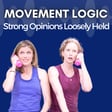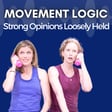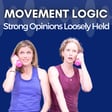
115: How to Get Abs
In this episode of the Movement Logic Podcast, Laurel Beversdorf and Dr. Sarah Court examine the enduring myths and misinformation around the aesthetic goal of “getting abs.” They analyze the anatomy and function of the abdominal muscles, the cultural evolution of ab training versus core strength and stability training, and the role mechanical tension, muscle length, and training volume play in hypertrophy (muscle growth). Additionally, they discuss how pursuing the aesthetic goal of "getting abs" is different from performance goals related to abdominal strength.
The hosts unpack popular misconceptions, such as “abs are made in the kitchen,” or that body composition changes work differently for women than men, or that core stability means never moving your spine. They contrast these myths with what current research on energy balance and hypertrophy training show. They also trace how Pilates, physical therapy, and social media helped shape the modern core strength and stability narrative—one that, in some circles, shifted from building strength through movement to “protecting” the lumbar spine by avoiding it.
Additionally, this episode aims to clarify all of the factors that influence the appearance of the abdominal region, and how gendered, moralized, and shame-based messaging about the midsection continues to distort public understanding of exercise and body image.
CART CLOSES Nov 1st for Lift for Longevity—SIGN UP
FOLLOW @MovementLogicTutorials on Instagram
RESOURCES
Clip: Mel Robbing Podcast interview with Stacy Sims about abs
67: Popular Explanations for SI Joint Pain are Wrong, Says Science
78: Behemoth Knee Myths
20: Pelvic Floor In-Depth with Stephanie Prendergast, MPT
54: Alignment Dogma - Spine
58: Alignment Dogma - Shoulders
48: Alignment Dogma - Pelvis
80: Posture Panic Pt. 3 with Author Dr. Beth Linker, PhD
50: Bracing versus Breathing
Slouch: Posture Panic in Modern America, by Beth Linker
Hodges, 2001; PMID: 11181617
Kalantari, 2024; PMID: 38565979
Brown, 2011; PMID: 21325932
Cholewicki, 1999; PMID: 10521659


